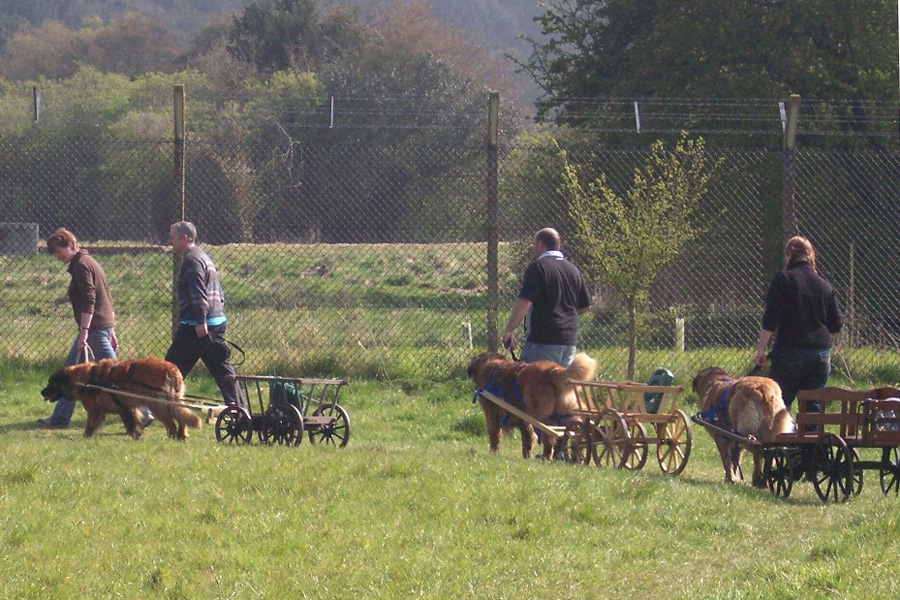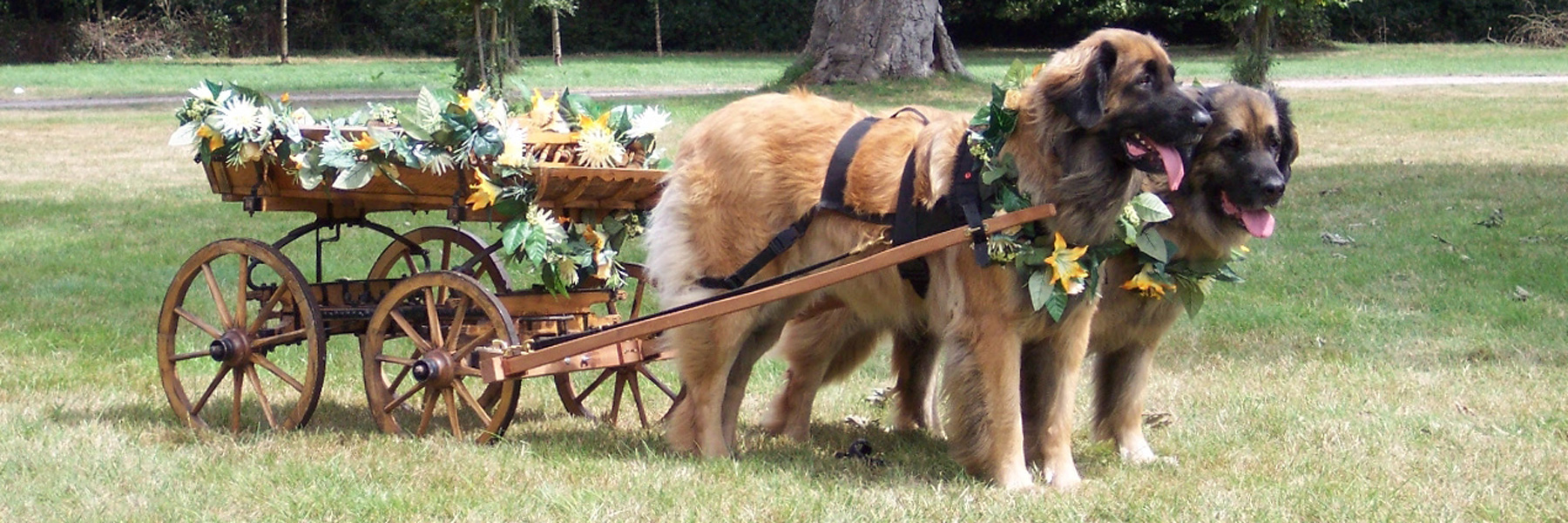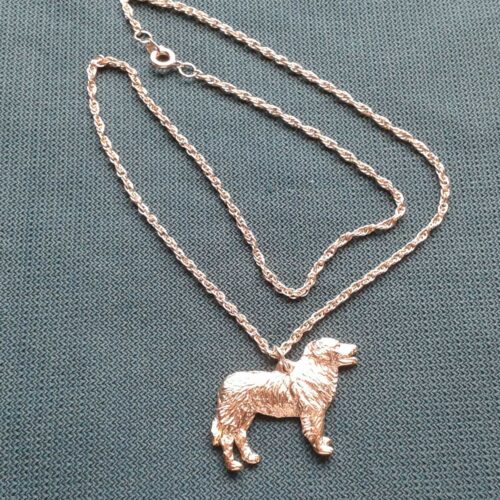Draught Work
Starting Carting
I have trained many Leos (and other breeds) to cart over the years and when people ask me about learning to cart or teaching their dog to cart the first thing that I do is recommend that they find a carting group and join it. It is so much easier and safer to learn from someone who knows what they are doing and to be able to see just what is required. Unfortunately not everyone is able to find a group close enough to them to join and many are left trying to work out how train their dogs to cart on their own, sometimes without ever having seen a dog harnessed and pulling a cart. I have seen all too many dogs badly hitched and harnessed which is not only uncomfortable for the dog but can also be quite dangerous, putting not only the dogs health and safety at risk but also that of the handler and others around it. So for this page I decided to put my fingers to the keyboard and put down the basics of teaching a dog to cart and also to point out some of the things to avoid.
Training area
Firstly of course you will need a dog, a cart, a harness and a safe area in which to train. I am very lucky in that our group train in my large garden or my paddock. We always start training on a level grassy area and try to have as few distractions as possible. Hard ground such as tarmac should be avoided at first as the noise made by the wheels of the cart or of the sledge being dragged can be very off putting and disturbing for a novice dog. Start on grass and then when the dog has built up confidence, move on to getting her used to other surfaces such as tarmac, gravel, stone, etc., but always be very aware that all of these surfaces make different noises which will be strange for your dog when wheels are pulled across them. The same thing applies to carts dropping down off kerbs the cart will not only feel different but will make a different sound.
Make sure that the area that you are training in is safe. Cars or other traffic pacing closely is to be avoided and can unsettle the novice dog. Also to be avoided is other dogs off lead and getting underfoot – this can be a problem when training in a park or other public place – so make sure you have plenty of helpers around.

The Dog
We never put a Leonberger in a cart until they are over one year old (and even then it will depend on the dog). A Leonberger pup is still growing at this age and their bones are still growing and fusing and so no unnecessary burden should ever be put on them until they are fully grown and able physically to cope with pulling a cart. This is not to say that they should not get used to wearing a harness and learning the commands used in carting, also just being around other dogs carting is helpful for the pup to be able to see that this new activity is good fun as they can see other dogs enjoying themselves with their carts. At what age should a pup be introduced to a harness? Any age – but we generally start when the pup is big enough to wear a carting harness without getting tangled up in it because it is too big for her – this is usually around 6 months upwards.
Before you start to think about carting with your Leo you should be teaching basic obedience skills and manners, especially how to walk calmly next to you, stop on command and listen to you when you give commands. It would be very dangerous to put at dog between the shafts if the owner had no control over their dog. The dog could easily panic, become frightened and throw themselves around trying to get out of the apparatus putting themselves and their handlers at serious risk of injury. Not only is training very important but also the temperament of the dog, is your dog one of those laid back types that takes life in her stride or is she a worrier or a little apprehensive? Knowing your dog and how she reacts to various stimuli is very useful in working out how quickly or slowly you will need to go when training her to be a carting dog.
The Harness
A carting harness is not the same as a harness that you would just use for taking your dog for a walk (please see photos). The harnesses that we use for carting dogs are very similar to those used by horses. Any harness should be well fitting with no pressure points or loose areas to rub against the dog – again please see photos. The harness should be neither too tight nor too loose. A typical harness will consist of a strong padded chest band, a padded band that fits at the back of the dogs neck (between the neck and the top of the shoulders), it will then usually have a further two straps over the back, the first of which is usually padded and in line with the girth and the second further along the back which is used to keep the breeching strap up. The girth goes under the dogs belly behind the front legs and either fastens with a buckle or plastic snap clip which should be positioned on the dog’s side. The breeching strap goes around the dog’s haunches (bum) and under the tail. This should not be too tight as it will cause discomfort nor should it be so loose as to cause chaffing – the breeching strap is used to stop the front of the cart bumping into the back of the dog when going downhill or stopping.
Harnesses are fitted to the shafts usually in two places, there should be a small strap on each side of the chest band which are used to fix the harness to the front of the shafts, there should be metal or brass fixings attached to the front of the shafts for this purpose. There will also be two long straps which run the length of the dog and will usually be attached by clips to brass or metal loops at the same point as the girth, these are called the tresses. The other ends of the tresses will be attached to the shafts where they join the front of the cart. The weight of the cart is pulled through the tresses so they need to be of even length. The tresses need to be adjustable and you must ensure that enough gap is left between the dog and the front of the cart so that when the dog moves her hocks/hind legs are not knocking into the front of the cart – also remember that when a dog moves at a faster pace her stride will lengthen, so enough room must be left to accommodate this.
Most of the harnesses that we use for carting today are made of strong webbing or I have seen some made of neoprene and come in a large array of colours and then of course there are the traditional leather harnesses with lovely brass fittings and buckles (and lots of elbow grease, brasso and saddle soap to keep them in tip top condition).
The Cart
Common sense is needed when choosing a cart, when putting a young dog into a cart for the first time a small, lightweight cart is needed. When we cart with Leonbergers we are looking for skill in Draught Work and not how much weight they can pull! If you have a smaller, lighter Leo find a smaller lighter cart. If you have one of the big heavy boys then a bigger cart will do the job. For more on different types of carts see the article in the Leonberger Club of GB Year Book 2009-2010.
The cart can have four wheels or two wheels either way the dog will pull it by being placed in the shafts which will be attached to the cart. We have already talked about the harness being attached to the shafts at two points – front and back. I will say again make sure you leave enough room at the back of the dog so that when walking she is not knocking her hocks into the front of the cart (I have seen this so many times) but also make sure that not too much length of shaft is sticking out at the front of the dog as this will make manoeuvring difficult and believe me getting hit in the back of the legs by the shafts is not much fun for the handler and can cause painful injury. One of my carts has rubber cups (the sort used on the bottom of walking sticks) on the end of the shafts – a great idea!
The Training
Now you have the dog, the harness, the cart and a nice safe training area sorted out – time to begin.
Most Leos like to work and take readily to pulling a cart. When we start training we start very slowly and work at the dog’s own pace. Some dogs are almost instant carters and take to it like they have been doing it all their lives, others take a little longer and it may be several sessions before you actually put your dog in a cart. This is fine, all dogs are different and it is so much better to take your time and make sure that the dog is happy with what she is doing than try to rush it and put her off.
We start with getting the dog used to wearing a harness (which they usually take to very quickly) we then move on to getting her used to pulling on something by getting someone to pull back on the tresses whilst the handler walks the Leo around giving the “forward” command. The dog should be used to walking calmly by the side of the handler without pulling on her lead so having to pull against the chest strap of the harness will be a new experience for her.
The next step is to get her used to the shafts without the cart attached. Putting a dog in a set of shafts is effectively “splinting” her body. When dogs turn they bend in the middle of their bodies, when we put them in shafts we are keeping their bodies straight so the dog will have to learn to turn right or left by moving their legs sideways and not bending their bodies. This is a “big ask” for a dog as not only are you keeping their bodies splinted but you are also preventing them from perusing their normal “flight or fight” response should they become frightened or anxious. This is why it is so important to make sure that your dog is safe and also comfortable in harness and between the shafts. I like to show the shafts to the dog first and maybe give a treat if she is accepting of them. The handler should be at the dog’s head holding the dog on a short lead and a second person should be behind the dog holding the back of the shafts – the shafts should be fixed to the front of the harness (I prefer a front fixing to the shafts that is easy and quick to undo should the dog become apprehensive). If the dog shows discomfort or distress speak calmly to her, keep a short lead, do not let her spin and get the person holding the shafts to remove them, walk her around a little, give her a rest and try again later.
Next we usually ask the dog to pull a light children’s sledge behind them (sometimes with a bag or small rock in it to give a little extra weight). At this point we often have an additional person as well as the handler walking beside the dog as some dogs can panic when they spot that “a weird plastic sledge like monster” is following them. Again let the dog see the sledge beforehand and maybe put a couple of treats onto the sledge for the dog to take (I did come unstuck recently with this method, as the young dog that we were training was not only a particularly laid back boy, but also very food orientated and during the training kept turning around and putting his paws on the sledge to stop it so that he could look for more treats!) It is very important that if the dog spots the sledge and panics that you take a firm hold of them and do not let them go into a spin. Handler holds dog – second person picks up sledge. When the dog is calm – start again. You may need to go back a step.
If all has gone well you may now want to put the dog into a cart. Start by getting someone to walk by your side pulling the cart themselves. They should move the cart in front, behind and at the side of the dog – this is to get the dog used to the cart and the noise that the cart makes whilst moving. If the dog is fine with this you may then hitch the dog to the cart. Have another person walking beside the dog on the other side to the handler – keep on the grass and take wide turns (remember the dog has to get used to side stepping as she is in shafts and not just bending her body as usual). Get her turning (wide turns) left and right. After a few circuits give her a rest and start again later again with two people. When you are confident that she is confident in the cart you can start to take her onto different surfaces again have someone on the other side of her. You can then move on to other obstacles like kerbs, gates etc..
Remember when training – go at the pace your dog is happy at – do not move on to the next step until the dog is confident with what she is doing. It is better to move forward slowly and get things right than to rush it and put the dog off. If you would like any advice or help please do not hesitate to contact me (or any of the other carting groups). I am only too happy to help people to enjoy their Leos.
Joining in with some Draught Tests is yet another way to have fun with your Leo.


